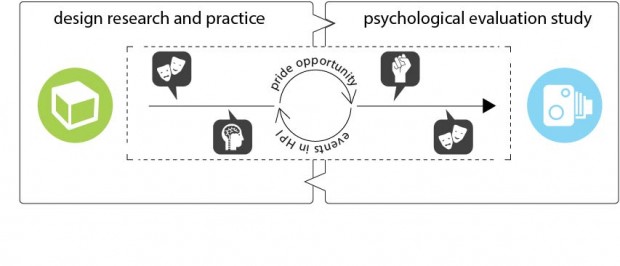This project is about designing interactions between people and products which let people experience specific emotions and covers both theory (Boehner, DePaula, Dourish, & Sengers, 2007; Demir, Desmet, & Hekkert, 2009; Fokkinga & Desmet, 2012; Hassenzahl, 2001; Hassenzahl, 2004; McDonagh, Bruseberg, & Haslam, 2002; Ross & Wensveen, 2010) and application (Buchenau & Suri, 2000; Kanis, Brinkman, & Perry, 2009), while additionally evaluating the design regarding the occurrence of an intended emotion empirically. Furthermore, it focusses on a specific user group during the design process: elderly people with dementia.
Target user group
The term “dementia” describes a set of symptoms that include loss of mental functions such as deficits of memory, problems with communication and reasoning, changes in personality, mood and behaviour (DSM-IV-TR, 2000). In an early phase of dementia, people often go through situations in which they experience rather negative emotions such as shame or embarrassment This is partly due to their cognitive impairments which lead to failing everyday tasks that they were always capable of doing in the past. When asked about her everyday life, a participant in this project pointed out that “The times are over that I feel proud”, which reconfirmed the value of focusing on a specific emotion in the design process.
Target emotion
Instead of avoiding negative feelings or solving problems of people with dementia, this project aimed at generating instances in daily life that enable people to experience positive emotions. After a first literature review on the emotional experience of the target user group, pride was selected to be focussed on. Pride is a social and self-conscious emotion originating from achievements that one attributes to one’s own abilities or efforts (Lewis, 1997; Tangney, 1999; Tracy & Robins, 2004; Webster et al., 2003).
Design process and evaluation of working interactive prototype
Based on two preliminary studies with emotion experience interviews following workbooks as well as user research with people with dementia and their formal and informal caregivers, this project makes use of “pride opportunities” in its design process. The developed pride opportunities are inspiring emotion attributes for designers, taking the time aspect of user experiences into account. After developing a design goal and principles, design concepts were generated. The selected concept was applied in the chosen context, day care centres for elderly people. It consisted of a social interaction including a music player that enables its users to autonomously choose and in a playful, tangible way try to match music from their past that stimulates autobiographic memories. A prototyping phase with iterative testing with people with dementia followed, until a final working interactive prototype was built.

In order to empirically test how a human product interaction incorporates the “pride opportunities” in the target user group, an evaluation study was conducted with 20 participants in the Netherlands and in Germany. The quantitative and qualitative evaluation proved the design process to be successful in eliciting an emotional user experience as not only significantly pride, but even stronger joy was measured in the participants. Professional care takers observing the interactions reported an added value for social stimulation and autonomous behaviour.
Relevance to psychology, design research and practice
Throughout the whole project, methods and approaches as well as findings for design and for the psychology discipline were intervened which leads to enriching benefits for both fields.
 From the point of view of emotion psychology, this project is the first reported to achieve emotion elicitation of a complex positive emotion by means of a human-product interaction in a social activity between several people. Other than in past psychological and geriatric studies, the present project introduced novel ways of stimulating positive emotions in people with dementia, by means of product design.
From the point of view of emotion psychology, this project is the first reported to achieve emotion elicitation of a complex positive emotion by means of a human-product interaction in a social activity between several people. Other than in past psychological and geriatric studies, the present project introduced novel ways of stimulating positive emotions in people with dementia, by means of product design.
Through the development of “pride opportunities”, the project went beyond the already applied way of using appraisal components for designing for distinct emotions. Concluding from the results and experiences of the project, guidelines for designers who aim to design for distinct emotions for hard to reach user groups were formulated. They can be sent on request. Regarding the resulting product, the author is eager to start the discussion with organisations interested in further development.
References
American Psychiatric Association (2000). Diagnostic and Statistical Manual of Mental Disorders, Fourth Edition, Text Revision: DSM-IV-TR, Washington, DC.
- Boehner, K., de Paula, R., Dourish, P. and Sengers, P. (2007). How emotion is made and measured. International Journal of Human Computer Studies. 65(4), 275-291.
- Buchenau, M. and Suri, J.F. (2000). Experience Prototyping. Proceedings of the 3rd Conference on Designing Interactive Systems: Processes, Practices, Methods, and Techniques 2000, ACM, N.Y., pp.424-433.
- Demir, E., Desmet, P. M. A., & Hekkert, P. (2009). Appraisal Patterns of Emotions in Human-Product Interaction. International Journal of Design, 3(2), 41-51.
- Fokkinga, S., Desmet, P.M.A. (2012). Meaningful Mix or Tricky Conflict? A Categorization of Mixed Emotional Experiences and Their Usefulness for Design. In Proceedings of the 8th International Conference on Design and Emotion.
- Hassenzahl, M. (2001). The Effect of Perceived Hedonic Quality on Product Appealingness. International Journal, 13(4), 481–499.
- Hassenzahl, M. (2004). Interaktive Produkte wahrnehmen, erleben, bewerten und gestalten. Design (pp. 1-26).
- ICD-10: International Statistical Classification of Diseases and Related Health Problems. Version: 2010. World Health Organisation. Retrieved December 3rd, 2011.
- Kanis, M., Brinkman, W-P. and Perry, M. (2009) Designing for positive disclosure: What do you like today? International Journal of Industrial Ergonomics, 39 (3), 564-572.
- Lewis, M. (1997). The self in self-conscious emotions. In J. G. Snodgrass & R. L. Thompson (Eds.), Self across psychology: Self-recognition, self-awareness, and the self-concept (pp. 119–142). New York: New York Academy of Sciences.
- McDonagh, D, Bruseberg, A, and Haslam, C (2002). “Visual Product Evaluation: Exploring Users’ Emotional Relationships with Products”. Applied Ergonomics: Human Factors in Technology and Society, 33(3), pp 231-240.
- Ross, P. R., & Wensveen, S. A. G. (2010). Designing aesthetics of behavior in interaction: Using aesthetic experience as a mechanism for design. International Journal of Design, 4(2), 3-13.
- Tangney, J. P. (1999). The self-conscious emotions: Shame, guilt, embarrassment and pride. In T. Dalgleish & M. J. Power (Eds.), Handbook of cognition and emotion (pp. 541–568). New York: Wiley.
- Tracy, J. L., & Robins, R. W. (2004). Show your pride: evidence for a discrete emotion expression. Psychological science, 15(3), 194-7.
- Webster, J. M., Duvall, J., Gaines, L. M., & Smith, R. H. (2003). The roles of praise and social comparison information in the experience of pride. Journal of Social Psychology, 143, 209-232.



